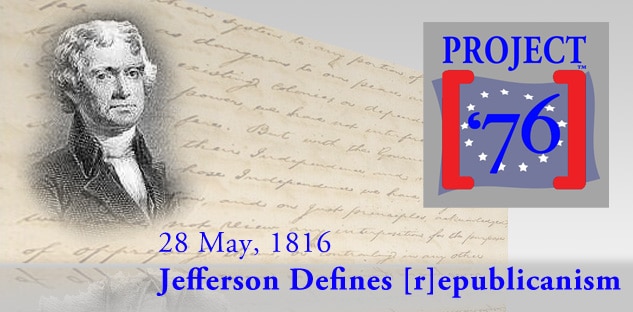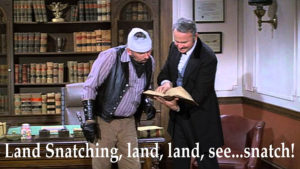-
 play_arrow
play_arrow
The CRUSADE Radio Network CRUSADE Radio Network
-
 play_arrow
play_arrow
PREVIEW: Bongino and Patel Detail Progress Mike "The KingDude" Church
-
 play_arrow
play_arrow
Audio Post Format TheKingDude


Mandeville, LA – (The following is a preview, courtesy of Nomocracy in Politics on libertarian judicial activism in Sandefur’s book)
Timothy Sandefur, the Conscience of the Constitution: The Declaration of Independence and the Right to Liberty (Cato Institute: Washington, D.C. (2014) (forthcoming)). viii + 199 pp. $24.95 cloth; $12.99 digital.
Libertarian legal scholar Timothy Sandefur endeavors in his latest tome to lay out an alternative judicial approach to the Progressive-inspired free rein for Congress and, when it comes to economic rights, for state legislatures under which we have lived since the Revolution of 1937. His theory, in which a particular conception of natural right should be considered judicially enforceable, would replace the Progressives’ beloved centralized, unlimited democracy with a regime in which judges exercised far more power. While perhaps appealing in the abstract, this proposal suffers from serious deficiencies.
Chief among those deficiencies is that Sandefur, citing Harry Jaffa, holds the Declaration of Independence to be the touchstone of constitutional correctness. In his 1791 “Opinion on the Constitutionality of a National Bank,” Secretary of State Thomas Jefferson had a different idea:
I consider the foundation of the Constitution as laid on this ground: That “all powers not delegated to the United States, by the Constitution, nor prohibited by it to the States, are reserved to the States or to the people.” [XIIth amendment.] To take a single step beyond the boundaries thus specially drawn around the powers of Congress, is to take possession of a boundless field of power, no longer susceptible of any definition.
If it were needed, further evidence disproving Sandefur’s claim that the Declaration made the states independent and melded them into one sovereignty could be found in the fact that by the time it was promulgated, Virginia’s first republican governor, Patrick Henry, had been in office for nearly a week
Sandefur’s idea of a certain kind of Lockean founding also encounters another obstacle: as Mark David Hall recently demonstrated in a fine biography of Connecticut Founder Roger Sherman, natural rights/natural law talk was not purely, or perhaps even primarily, a Lockean argot at the time of the Revolution. Far more Americans subscribed to Calvinism than to any other creed in America in the late eighteenth century, and Calvinism included the ideas of natural right, the right of revolution, etc., just as Lockeanism did. In fact, Hall speculates that Calvin influenced Locke, so that one might nearly say that Locke was a Calvinist on this score. If, then, we are to read the Constitution through a natural-law lens because that is the way the people meant for it to be read when they ratified it, there is reason to doubt that an overwhelmingly Protestant, highly Calvinist population understood natural right in the way that Sandefur wants today’s officials to understand it.

Sandefur’s claims about the Declaration’s place in American history suffer from a yet more basic weakness than this: when he says, for example, that “the Declaration of Independence. . .created the United States as a political unit and defines the terms of its sovereignty” (p. 2), there is nothing to support him.
The Declaration, like other documents of the same genre, made an announcement; it did not establish the states’ independence. Like other declarations, it had no legal effect—pace Sandefur. (pp. 14–15) Sandefur would have known this if he had read the outstanding scholarly treatment of the subject, the late MIT professor Pauline Maier’s classic American Scripture: Making the Declaration of Independence.
Of course, one need not have read Maier’s book to know that, during the Revolution, no one would have said that the Declaration of Independence founded anything. It had not been ratified by the people, nor had it been adopted by anyone with authority to speak for the people in elaborating a political philosophy. The congressmen, each representative of a state, had been instructed either to declare independence (in the Virginians’ case) or to join in the cause in case other states did (most of the other congressmen). That was all.
If it were needed, further evidence disproving Sandefur’s claim that the Declaration made the states independent and melded them into one sovereignty could be found in the fact that by the time it was promulgated, Virginia’s first republican governor, Patrick Henry, had been in office for nearly a week. He was inaugurated on June 29, 1776. Virginians of that day, and at least through the state constitutional convention of 1829–30, dated their Commonwealth to May 15, 1776, when the revolutionary Convention adopted resolutions for a declaration of rights, a republican constitution, federal relations, and treaty relations.

All of this shows that not liberty, but federalism is the federal Constitution’s underlying assumption—just as Jefferson said in 1791. Sandefur gets this wrong throughout the book, viz., “Even the requirement that a bill must receive a majority vote in both houses before it can become law makes sense only if the Constitution’s authors intended a presumption in favor of liberty, with restrictions only permitted for good reasons.”
In his book’s second chapter, Sandefur attacks Jefferson’s understanding head-on. “The States’ Rights Party,” he says, “held that sovereignty resides primarily in each separate state and that the federal government’s powers are delegated to it by the states, not by the people.” (p. 33) Here we see evidence that Sandefur’s training is as an attorney, because he echoes the claims made by Chief Justice John Marshall in a string of cases—cases that form the germ of any constitutional law class.
Sandefur denies that the states created the Federal Government. Unfortunately for him, readers of his book can be expected to be familiar with Article VII of the Constitution, which says that the Constitution will go into effect among the ratifying states as soon as nine states have ratified. So who ratified? The states, in Madison’s sense of the word “state”—the sovereign people of each state….
Written by: TheKingDude
Similar posts
Featured post
Latest posts

The War Power To Take Out Cartels: Letters of Marque & Reprisal-Mike’s 2014 LPAC Speech

Brad Birzer and Winston Elliott Discuss “A New Dark Age”

Trump Should Read Thomas Jefferson’s First Inaugural Speech

Kamala Harris: The Shape Of Modern Evil, A Halloween Commentary
Mike Church Show- Review of 2016 Al Smith Dinner That Invited Killary
Current show
Upcoming shows

Mike Church Show Afternoon Replay
If You Missed The Live! Morning Drive Version
5:00 pm - 8:00 pmMike Church Show Weekend Best Of
12:00 am - 11:59 pm
Condimentum Elit
11:40 pm - 11:55 pm
Chart
HERE IT GOES YOUR COPYRIGHT TEXT. CAN ALSO CONTAIN LINKS LIKE THIS






Post comments (0)